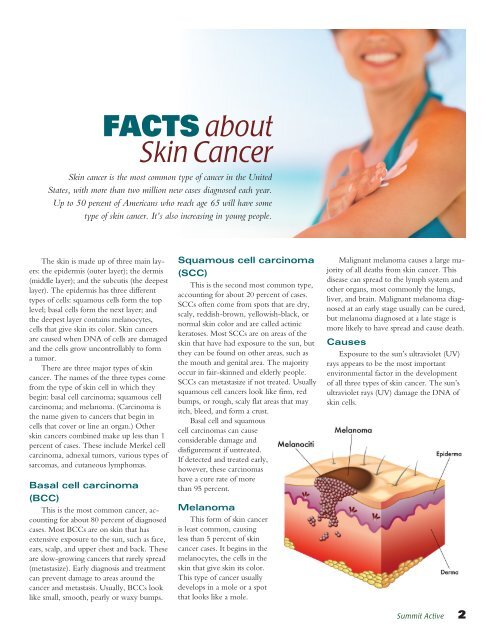active - Summit Healthcare
active - Summit Healthcare
active - Summit Healthcare
You also want an ePaper? Increase the reach of your titles
YUMPU automatically turns print PDFs into web optimized ePapers that Google loves.
FACTS about<br />
Skin Cancer<br />
Skin cancer is the most common type of cancer in the United<br />
States, with more than two million new cases diagnosed each year.<br />
Up to 50 percent of Americans who reach age 65 will have some<br />
type of skin cancer. It’s also increasing in young people.<br />
The skin is made up of three main layers:<br />
the epidermis (outer layer); the dermis<br />
(middle layer); and the subcutis (the deepest<br />
layer). The epidermis has three different<br />
types of cells: squamous cells form the top<br />
level; basal cells form the next layer; and<br />
the deepest layer contains melanocytes,<br />
cells that give skin its color. Skin cancers<br />
are caused when DNA of cells are damaged<br />
and the cells grow uncontrollably to form<br />
a tumor.<br />
There are three major types of skin<br />
cancer. The names of the three types come<br />
from the type of skin cell in which they<br />
begin: basal cell carcinoma; squamous cell<br />
carcinoma; and melanoma. (Carcinoma is<br />
the name given to cancers that begin in<br />
cells that cover or line an organ.) Other<br />
skin cancers combined make up less than 1<br />
percent of cases. These include Merkel cell<br />
carcinoma, adnexal tumors, various types of<br />
sarcomas, and cutaneous lymphomas.<br />
Basal cell carcinoma<br />
(BCC)<br />
This is the most common cancer, accounting<br />
for about 80 percent of diagnosed<br />
cases. Most BCCs are on skin that has<br />
extensive exposure to the sun, such as face,<br />
ears, scalp, and upper chest and back. These<br />
are slow-growing cancers that rarely spread<br />
(metastasize). Early diagnosis and treatment<br />
can prevent damage to areas around the<br />
cancer and metastasis. Usually, BCCs look<br />
like small, smooth, pearly or waxy bumps.<br />
Squamous cell carcinoma<br />
(SCC)<br />
This is the second most common type,<br />
accounting for about 20 percent of cases.<br />
SCCs often come from spots that are dry,<br />
scaly, reddish-brown, yellowish-black, or<br />
normal skin color and are called actinic<br />
keratoses. Most SCCs are on areas of the<br />
skin that have had exposure to the sun, but<br />
they can be found on other areas, such as<br />
the mouth and genital area. The majority<br />
occur in fair-skinned and elderly people.<br />
SCCs can metastasize if not treated. Usually<br />
squamous cell cancers look like firm, red<br />
bumps, or rough, scaly flat areas that may<br />
itch, bleed, and form a crust.<br />
Basal cell and squamous<br />
cell carcinomas can cause<br />
considerable damage and<br />
disfigurement if untreated.<br />
If detected and treated early,<br />
however, these carcinomas<br />
have a cure rate of more<br />
than 95 percent.<br />
Melanoma<br />
This form of skin cancer<br />
is least common, causing<br />
less than 5 percent of skin<br />
cancer cases. It begins in the<br />
melanocytes, the cells in the<br />
skin that give skin its color.<br />
This type of cancer usually<br />
develops in a mole or a spot<br />
that looks like a mole.<br />
Malignant melanoma causes a large majority<br />
of all deaths from skin cancer. This<br />
disease can spread to the lymph system and<br />
other organs, most commonly the lungs,<br />
liver, and brain. Malignant melanoma diagnosed<br />
at an early stage usually can be cured,<br />
but melanoma diagnosed at a late stage is<br />
more likely to have spread and cause death.<br />
Causes<br />
Exposure to the sun’s ultraviolet (UV)<br />
rays appears to be the most important<br />
environmental factor in the development<br />
of all three types of skin cancer. The sun’s<br />
ultraviolet rays (UV) damage the DNA of<br />
skin cells.<br />
<strong>Summit</strong> Active 2






